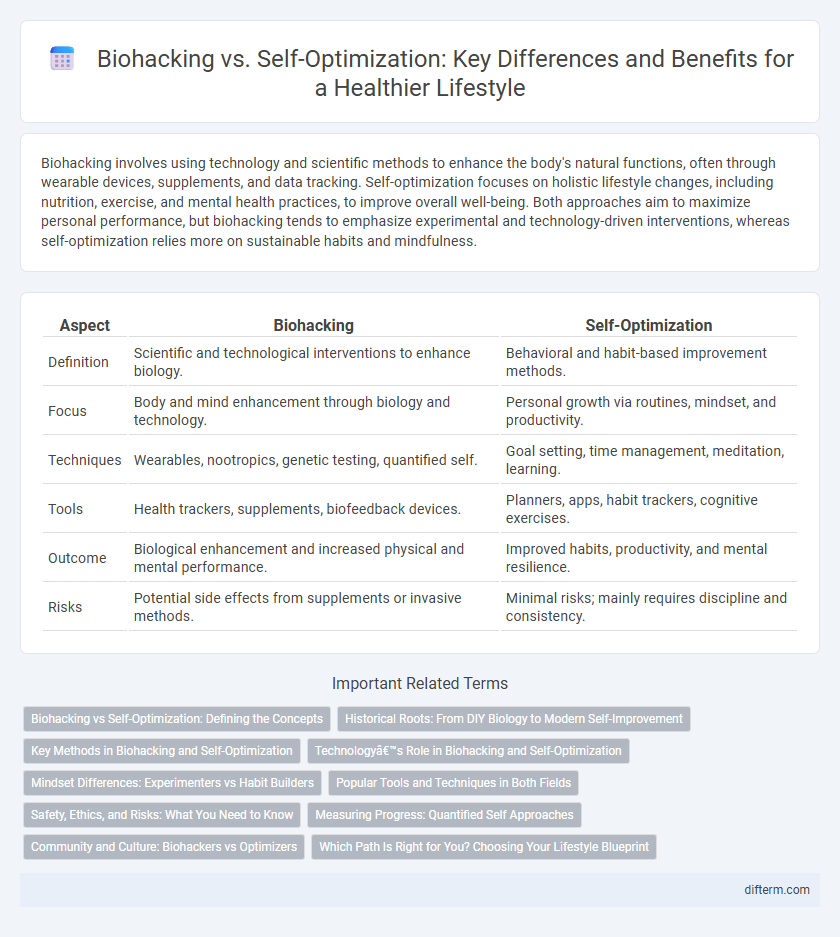Biohacking involves using technology and scientific methods to enhance the body's natural functions, often through wearable devices, supplements, and data tracking. Self-optimization focuses on holistic lifestyle changes, including nutrition, exercise, and mental health practices, to improve overall well-being. Both approaches aim to maximize personal performance, but biohacking tends to emphasize experimental and technology-driven interventions, whereas self-optimization relies more on sustainable habits and mindfulness.
Table of Comparison
| Aspect | Biohacking | Self-Optimization |
|---|---|---|
| Definition | Scientific and technological interventions to enhance biology. | Behavioral and habit-based improvement methods. |
| Focus | Body and mind enhancement through biology and technology. | Personal growth via routines, mindset, and productivity. |
| Techniques | Wearables, nootropics, genetic testing, quantified self. | Goal setting, time management, meditation, learning. |
| Tools | Health trackers, supplements, biofeedback devices. | Planners, apps, habit trackers, cognitive exercises. |
| Outcome | Biological enhancement and increased physical and mental performance. | Improved habits, productivity, and mental resilience. |
| Risks | Potential side effects from supplements or invasive methods. | Minimal risks; mainly requires discipline and consistency. |
Biohacking vs Self-Optimization: Defining the Concepts
Biohacking involves using science, technology, and lifestyle changes to enhance physical and mental performance at a biological level, often incorporating quantifiable data and experimental methods. Self-optimization centers on improving habits, productivity, and personal growth through goal-setting, mindfulness, and behavioral adjustments without necessarily engaging in biological experimentation. Understanding these distinctions highlights biohacking's emphasis on empirical bio-data manipulation versus self-optimization's focus on psychological and behavioral refinement.
Historical Roots: From DIY Biology to Modern Self-Improvement
Biohacking originated from the DIY biology movement of the late 20th century, emphasizing grassroots experimentation and personal control over biology. Self-optimization evolved from traditional self-improvement practices, integrating advances in neuroscience, psychology, and technology to enhance cognitive and physical performance. Both approaches share historical roots in the quest for human enhancement but diverge in methodology, with biohacking prioritizing experimental biological interventions and self-optimization focusing on structured lifestyle changes.
Key Methods in Biohacking and Self-Optimization
Key methods in biohacking include quantified self-tracking with wearable devices, intermittent fasting, nootropics, and personalized nutrition plans based on genetic testing. Self-optimization strategies emphasize habit formation, mindfulness practices, goal setting with SMART criteria, and cognitive behavioral techniques to improve productivity and mental resilience. Both approaches leverage data-driven insights and behavioral adjustments to enhance physical and mental performance.
Technology’s Role in Biohacking and Self-Optimization
Technology plays a pivotal role in biohacking and self-optimization by providing advanced tools such as wearable devices, genetic testing, and AI-driven health analytics that enable individuals to monitor and enhance their physical and mental performance. These innovations facilitate personalized data tracking, allowing users to make informed decisions about nutrition, sleep, and exercise for optimized well-being. The integration of technology ensures continuous feedback loops and adaptive strategies, pushing the boundaries of human potential through precise, data-driven interventions.
Mindset Differences: Experimenters vs Habit Builders
Biohackers prioritize rapid experimentation with cutting-edge techniques and data-driven adjustments to enhance mental and physical performance, often embracing a trial-and-error mindset. Self-optimization advocates focus on consistent habit building and incremental improvements, valuing stability and long-term behavioral changes to sustain growth. The key mindset difference lies in biohackers' openness to frequent, novel interventions versus self-optimizers' dedication to disciplined, habitual routines.
Popular Tools and Techniques in Both Fields
Popular tools in biohacking include wearable devices like continuous glucose monitors, nootropic supplements, and DIY biology kits for genetic experimentation. Self-optimization techniques often involve mindfulness meditation apps, habit-tracking software, and personalized fitness programs driven by data analytics. Both fields leverage technology and data to enhance physical and cognitive performance, but biohacking tends to emphasize biological experimentation, while self-optimization focuses more on behavior change and mental wellness.
Safety, Ethics, and Risks: What You Need to Know
Biohacking involves experimenting with biological systems to enhance physical and mental performance, often using technology or supplements, whereas self-optimization emphasizes holistic lifestyle changes grounded in established health practices. Safety concerns in biohacking include unregulated substances and potential long-term health impacts, while self-optimization generally carries fewer risks due to its reliance on evidence-based methods. Ethical considerations also arise in biohacking regarding consent and accessibility, making it crucial to understand the potential dangers and moral implications before engaging in either approach.
Measuring Progress: Quantified Self Approaches
Biohacking leverages advanced biometric tools and wearable technology to collect real-time physiological data, enabling precise measurement of sleep patterns, heart rate variability, and metabolic functions. Self-optimization incorporates quantified self approaches through journaling, habit tracking apps, and performance metrics analysis to monitor behavioral changes and productivity trends. Combining biofeedback with data analytics enhances personalized strategies for continuous lifestyle improvement and goal attainment.
Community and Culture: Biohackers vs Optimizers
Biohackers often thrive in niche communities that emphasize experimental techniques and cutting-edge technology to push human limits, fostering a culture of innovation and open sharing. Self-optimizers typically engage in broader lifestyle groups centered around gradual improvement, mindfulness, and sustainable habits, promoting a culture of balance and long-term wellness. These distinct cultural frameworks influence how members prioritize goals, methods, and collaboration within their respective communities.
Which Path Is Right for You? Choosing Your Lifestyle Blueprint
Biohacking leverages technology and biology to enhance physical and mental performance, focusing on measurable data like sleep quality, hormone levels, and neural activity. Self-optimization emphasizes holistic habits such as mindfulness, nutrition, and exercise tailored to individual goals and well-being. Evaluate your lifestyle demands, health priorities, and willingness to experiment with biofeedback tools to determine whether a science-driven or habit-based approach best suits your personal growth blueprint.
biohacking vs self-optimization Infographic

 difterm.com
difterm.com